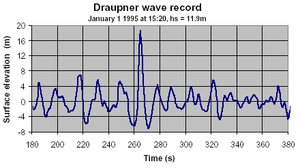Draupner wave

The Draupner wave or New Year's wave was the first rogue wave to be detected by a measuring instrument, occurring at the Draupner platform in the North Sea off the coast of Norway on 1 January 1995. In an area with significant wave height of approximately 12 metres (39 ft), a freak wave with a maximum wave height of 25.6 metres (84 ft) occurred (peak elevation was 18.5 metres (61 ft)). Prior to that measurement, no instrument-recorded evidence for rogue waves existed--just anecdotal evidence provided by those who had encountered them at sea, although ships such as the British Ocean Weather Reporter had recorded very large waves that did not differ quite enough from their neighbors to be considered rogue.[1]
Minor damage was inflicted on the platform during this event, confirming the validity of the reading made by a downwards-pointing laser sensor.
References
- Sverre Haver (5 August 2003). Freak wave event at Draupner jacket 1 January 1995. (PDF) retrieved 20 May 2016
- Paul H. Taylor. The shape of the Draupner Wave of 1 January 1995 (PDF) retrieved 20 January 2007.
- YouTube. Video reconstruction of rogue waves, from BBC documentary.
- "On the crest of a freak wave" Oxford Science Blog article of Draupner wave